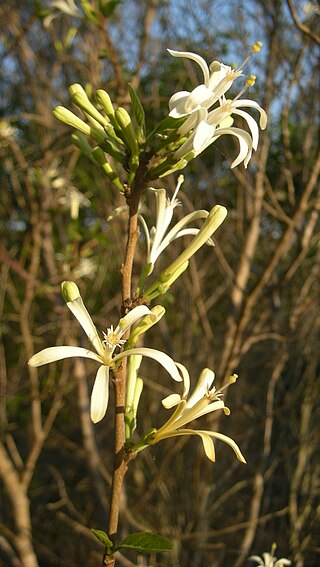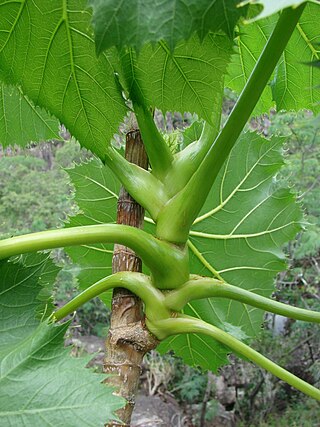
Argomuellera is a genus of plant of the family Euphorbiaceae first described as a genus in 1894. It is native to sub-Saharan Africa, Madagascar, and the Comoros Islands.

Heinrich Gustav Adolf Engler was a German botanist. He is notable for his work on plant taxonomy and phytogeography, such as Die natürlichen Pflanzenfamilien, edited with Karl A. E. von Prantl.

Turraea is a genus of plants in the family Meliaceae, native to the Old World tropics and subtropics.

Bolusanthus speciosus is a species of flowering plants in the family Fabaceae. It belongs to the subfamily Faboideae. It is the only member of the genus Bolusanthus.
Grazielodendron riodocensis is a species of flowering plant in the legume family, Fabaceae. It belongs to the subfamily Faboideae, and was recently assigned to the informal monophyletic Pterocarpus clade within the Dalbergieae. It is the only member of the genus Grazielodendron. It is only found in eastern Brazil.
Steyermarkochloa is a genus of plants in the grass family. The only known species is Steyermarkochloa angustifolia(Spreng.) Judz., which is native to Colombia (Guainía), Venezuela (Amazonas), and Brazil (Amazonas).
Schenckochloa is a monotypic genus of flowering plants belonging to the family Poaceae. It only contains one known species, Schenckochloa barbata(Hack.) J.J.Ortíz
Tessmanniacanthus is a monotypic genus of flowering plants belonging to the family Acanthaceae. It only contains one known species, Tessmanniacanthus chlamydocardioidesMildbr.
Goodallia is a monotypic genus of flowering plants belonging to the family Thymelaeaceae. It just contains one species, Goodallia guianensisBenth.

Klotzschia is a genus of flowering plants belonging to the family Apiaceae. It is native to Brazil.

Kuhlmanniodendron is a genus of flowering plants belonging to the family Achariaceae.
Recordia is a genus of flowering plants belonging to the family Verbenaceae.
Normandiodendron is a monotypic genus of flowering plants belonging to the family Fabaceae. It only contains one known species, Normandiodendron bequaertii(De Wild.) J.Léonard
Petiniotia is a monotypic genus of flowering plants belonging to the family Brassicaceae. It only contains one known species, Petiniotia purpurascens(Boiss.) J.Léonard
Schunkea is a monotypic genus of flowering plants belonging to the family Orchidaceae. The only known species is Schunkea vierlingii.
Schlechterina is a monotypic genus of flowering plants belonging to the family Passifloraceae. The only knowns species is Schlechterina mitostemmatoides.
Helmontia is a genus of flowering plants belonging to the family Cucurbitaceae.
Hockinia is a monotypic genus of flowering plants belonging to the family Gentianaceae. The only species is Hockinia montana. It is native to south-eastern Brazil.
Krukoviella is a monotypic genus of flowering plants belonging to the family Ochnaceae. It has one synonym PlanchonellaTiegh. The only species is Krukoviella disticha(Tiegh.) Dwyer
Sohnreyia is a genus of flowering plant in the Citrus, or Rue family (Rutaceae), native to South America. They are all "palmoids" or Corner Model Trees. As such they most commonly consist of a single, pachycaul trunk topped by a rosette of very large, pinnate leaves, and are usually monocarpous. The genus was first described by Kurt Krause in 1914. The genus name of Sohnreyia is in honour of Heinrich Sohnrey (1859–1948), a German teacher and writer.





